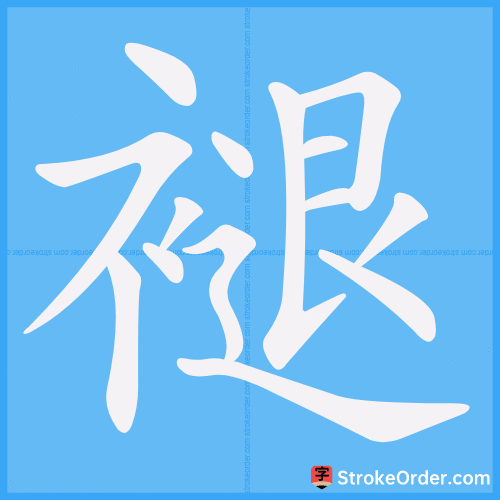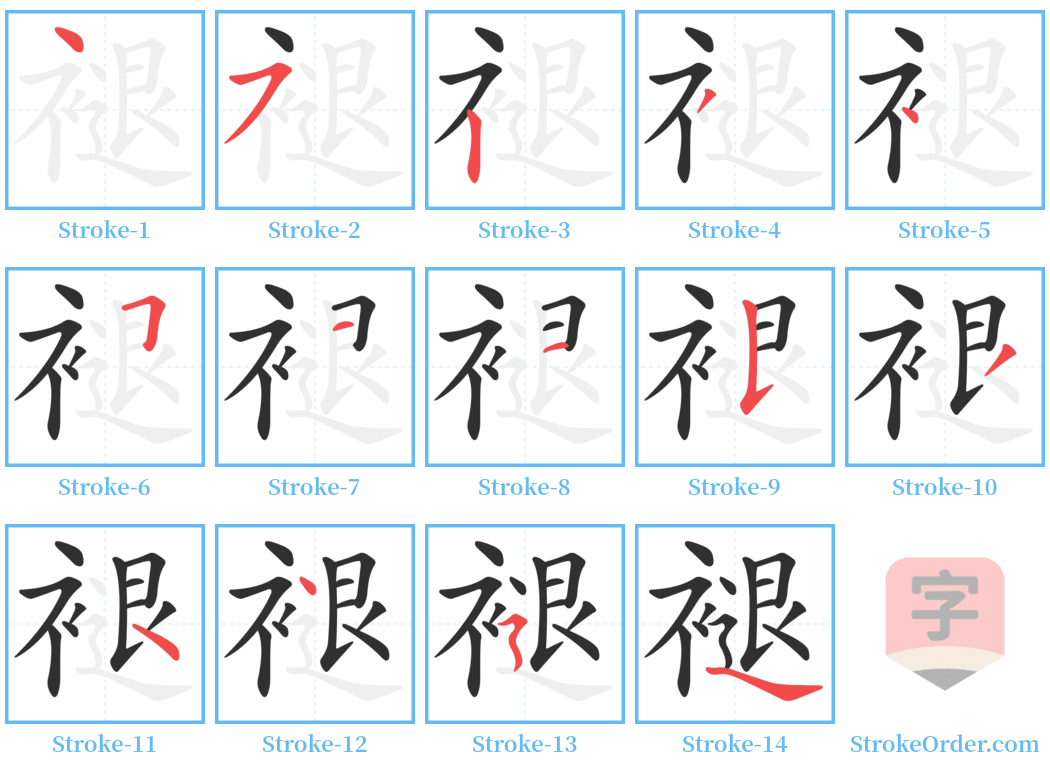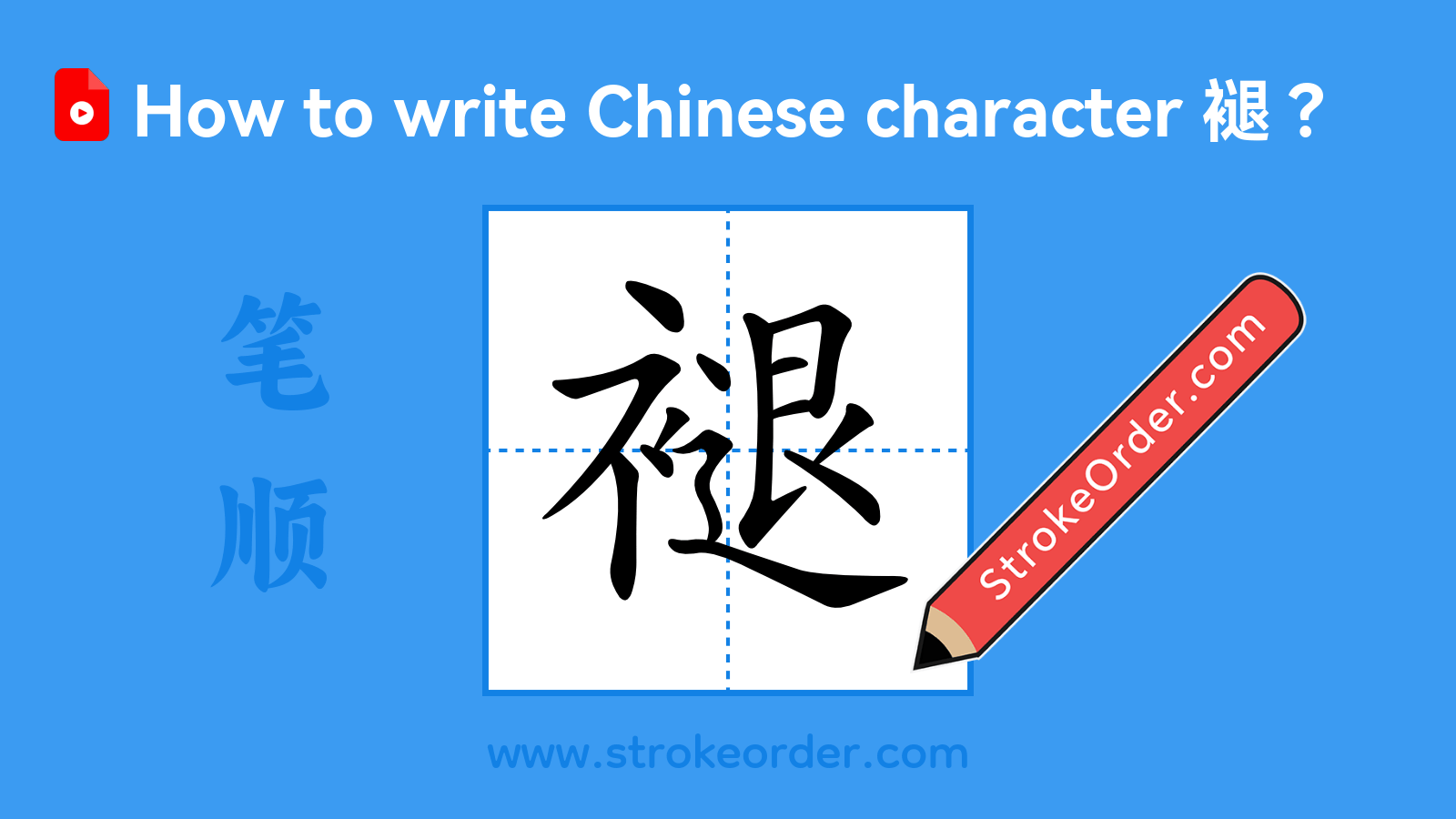褪 Stroke Order
Animated Stroke Order of 褪

Stroke Order Diagrams for 褪

Step-by-Step Handwriting Guide for 褪

Learn to Write Chinese Characters with Video Tutorials
Watch the video of writing the Chinese character "褪", learn the correct stroke order (笔顺) of the character "褪", and master the standard way of writing the character "褪".

Free Printable Handwriting Practice with Stroke Order: 褪
Printable Writing Practice Worksheet of "褪" in Portrait Orientation (Tian Zi Ge)

Printable Writing Practice Worksheet of "褪" in Landscape Orientation (Tian Zi Ge)

Information of 褪
Pinyintuì、 tùn
Radical
衤
Strokes
14 strokes
Usage
★★★★★
Definition
fade / take off (clothes)
褪 [tuì] 1. To fall off, to shed. Example: When the plums shed their flowers, they align with the yellow plums. To take off clothing. The rabbit is shedding its fur. 2. To fade or disappear in color. Example: Faded color. The color has completely faded. 褪 [tuì] 1. To shed clothing or something worn. Example: To take off the sleeves. 2. To withdraw and hide. Example: To tuck one's hands into the sleeves. 3. To retreat or escape. Example: Don't just retreat when encountering difficulties. 褪 [tùn] 1. To take off. Example: The original meaning is to undress. 2. To eliminate or vanish. 3. To wither or wilt. 4. To relieve. 5. To loosen. 6. See also tuì. 褪 [tùn] 1. To take off. Example: According to "Yunhui," it means to take off clothes. 2. To vanish. Example: As expressed in a poem by Lu You: The spring activities are dwindling; the mountain village has not yet shed the cold. 3. To wither. Example: As mentioned in a poem by Xin Qiji: When the plums shed their flowers, they align with the yellow plums. 4. To relieve. Example: In "Heroes of the Children and Daughters," it states: Saying this, he took off the slingshot and handed it over. 5. To loosen. Example: In a poem: When I become thin, I suddenly feel my green shirt loosen. 6. See also tuì.
to fade (of colors) / also pr. [tui4 shai3]
fade
to take off (one's clothes) / (fig.) to shed (one's former image etc) / (of a fad or the after-effects of a disaster etc) to subside / also pr. [tun4 qu4]
Input Method for 褪
Pinyintui4
Wubi
puvp
Cangjie
lyav
Zhengma
wtwx
Four Corner
37233
Unicode
U+892a
Same Pronunciation Characters
推腿蜕褪退颓煺蛻頹蓷藬僓隤尵頽頺魋蘈蹪穨俀脮蹆骽娧駾㢈㢑㞂㱣㷟㦌䅪䀃㾯㾼㾽㿉㿗䍾䫋
Same Radical Characters
补衫衬袄袍袖袜被袱裕裙裤裸褂褐褥褪襟衩衲衽衿袂袒袢袷裆裉裎裢裥裨裰裱裾褊褓褙褚褛褟褡褫褴褶襁襦襻衤衹袟袯袴袼裇補裡裣裼複褲褳褵褸襖襠襢襤襪襫襯袮襬袐襅襣褾襒袚襏襮褿襙褨裧襜襌裮袳裭褈裯襊襶褝衴袛褋襩
本文来自细雨轻轻打投稿,不代表汉字笔顺中文网英文版立场,如若转载,请注明出处:https://www.strokeorder.cn/strokeorder/24961.html

 微信扫一扫
微信扫一扫 